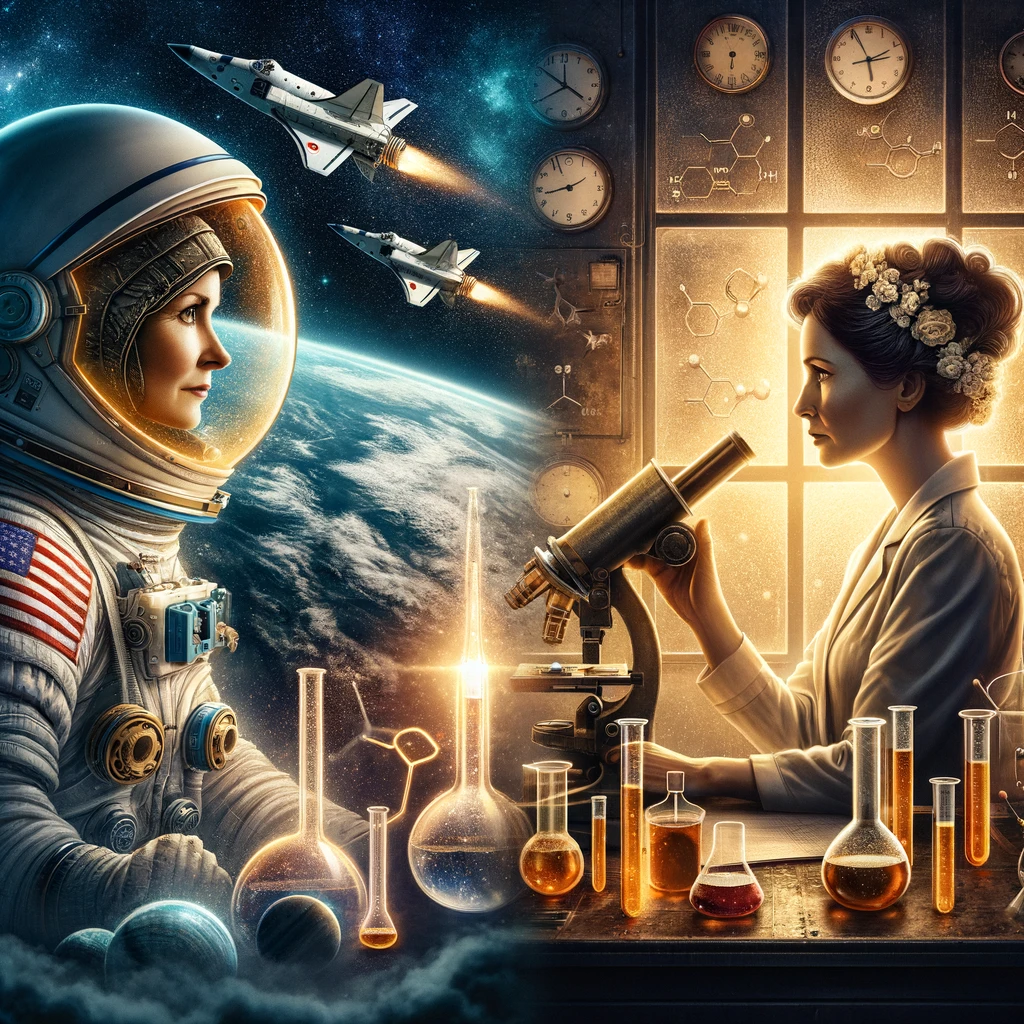
Women’s History Month
In the tapestry of history, certain women leave an enduring mark, their stories inspiring generations. This Women’s History Month, we honor two such luminaries: Dr. Sally Ride, who shattered the ultimate barrier for American women by soaring into space, and Marie Curie, the Nobel Prize-winning physicist whose discoveries in radioactivity revolutionized our world. Their journeys remind us of the immense power of intellect, determination, and the relentless pursuit of knowledge.
Dr. Sally Ride
Dr. Sally Ride, a brilliant physicist and astronaut, etched her name in history as the first American woman in space. Born in Los Angeles in 1951. An outstanding junior tennis player and excellent, she first attended Swarthmore College, where she was admitted on a full scholarship. With an original goal of becoming a professional tennis player and realizing Swarthmore’s location did not allow her to play year-round, she returned home and enrolled at UCLA, where she became the only woman majoring in physics. Her foray into professional tennis did not work out. After playing 3 matches during a tournament on a single morning, her body took a beating. Realizing she probably needed to practice eight hours a day to become a competitive pro, she concluded she did not have the desire to pursue a professional career.
In 1971, Ride enrolled at Stanford. She graduated in 1973 with undergraduate degrees in physics and English literature. In 1975, she earned a M.S. in physics, and in 1978 received her doctorate on the strength of her dissertation on the “Interaction of X-rays with the Interstellar Medium.” In 1977, she saw an article that talked about how NASA was recruiting a new group of astronauts for the Space Shuttle program. She was one of 8,079 applicants for the program and became a finalist. In 1978, she was officially selected as part of NASA Astronaut Group 8. Here are five of her greatest accomplishments/achievements:
1. First American Woman in Space
Ride’s 1983 flight aboard the Space Shuttle Challenger as a Mission Specialist was a monumental leap for women in science and made her a national hero. She flew on a second Challenger mission in 1984.
2. Mission Specialist Expertise
A highly skilled mission specialist, Ride operated the extremely complicated robotic arm on both missions. The arm was used to conduct important scientific experiments, and also released satellites into space.
3. Champion of STEM Education
After her NASA career, Ride co-founded Sally Ride Science along with her life partner, Tam O’Shea, and three colleagues, – Karen Flammer, Terry McEntee, and Alan Lopes. Their goal was to promote equity and inclusion for all students, especially girls, in STEM (science, technology, engineering and math) studies and careers.
4. As an Author and Educator
Dr. Sally Ride used her platform as an astronaut, scientist, and activist, to write children’s books about space exploration, and served as a professor of physics at the University of California at San Diego, and Director of the California Space Institute.
5. Presidential Commissions
Ride’s expertise was highly valued, and she served on the President’s Committee of Advisors on Science and Technology (PCAST) as well as the committee investigation the tragic Challenger accident.
Dr. Sally Ride’s pioneering spirit and dedication to education were exemplary. She broke the ultimate barrier, proving that women could “boldly venture where no American woman had gone before.” More than just an astronaut. Ride used her fame to inspire generations, ensuring young girls would see themselves fully represented in the future of science and space exploration.
Marie Curie
Maria Salome Sklodowska-Curie, known as Marie Curie, was a Polish and naturalized-French physicist and chemist who conducted pioneering research on radioactivity. Born in Warsaw, Poland, she was the youngest of the five children of well-known teachers Bronislawa and Wladyslaw Sklodowski. An exceptional student, she moved to Paris to begin her advanced studies. She enjoyed a career where she would become the first woman to win a Nobel Prize, the first person to win Two Nobel Prizes, and the only person to win a Nobel Prize in two different fields. Her husband Pierre Curie, was a co-winner of her first Nobel Prize, making them the first-ever married couple to win the Nobel Prize, and launching the Curie family legacy family legacy of five Nobel Prizes. In 1906, she became the first woman to become a professor at the University of Paris. Here’s a look at five of her most significant accomplishments:
1. Discovery of Radioactivity
Curie’s doctoral research focused on the rays emitted by uranium, which had recently been discovered by Henri Becquerel. Working with her husband Pierre, they were able to isolate two of the unknown elements responsible for the strong rays: polonium and radium. Unfortunately, her work with these radioactive substances would eventually lead to her death.
2. First Woman Nobel Prize Winner
In 1903, Curie received the Nobel Prize in Physics, shared with her husband, Pierre, and Henri Becquerel, for their research on radioactivity. She also coined the phrase ”radio-active” to describe polonium and radium.
3. First Person to Win Nobel Prizes in Two Different Fields
Curie remains the only woman to win Nobel Prizes in different fields. In 1911, she received the Nobel Prize in Chemistry for isolating pure radium which results from the radioactive decay of uranium.
4. Development of X-Rays for Medicine
During WWI, Curies promoted the use of X-rays. She developed radiological cars, – which became knows as “petites Curies” – to allow battlefield surgeons to x-ray wounded soldiers and operate more accurately. She also oversaw the construction of 200 radiological rooms at various fixed field hospitals behind battle lines.
5. Inspiring a Scientific “Dynasty”
Marie Curie’s daughter, Irene Joliot-Curie, and her husband, Frederic Joliot-Curie, jointly won the 1935 Nobel Prize in chemistry for their discovery of artificial radioactivity.
Marie Curie’s research on radioactivity revolutionized physics and paved the way for advancements in medicine, technology, and a better understanding of the universe. As the first woman to win a Nobel Prize, and first person to win two, her accomplishments continue to inspire generations of scientists. Unfortunately, while tirelessly pursuing her research, Curie unknowingly exposed herself to harmful levels of radiation. This ultimately led to her tragic death in 1934. Her life and premature death serve as a solemn reminder of the risks pioneers take to unlock knowledge for the betterment of humankind.



